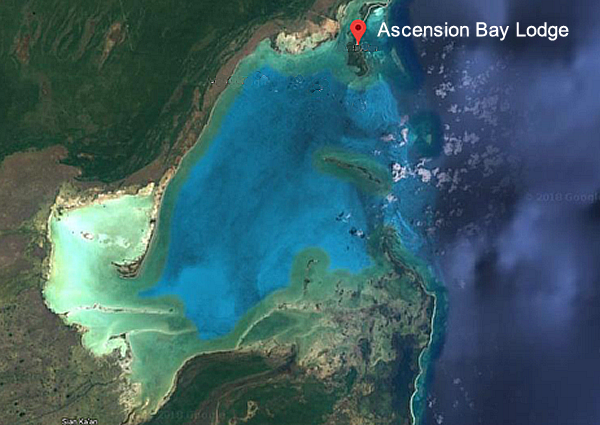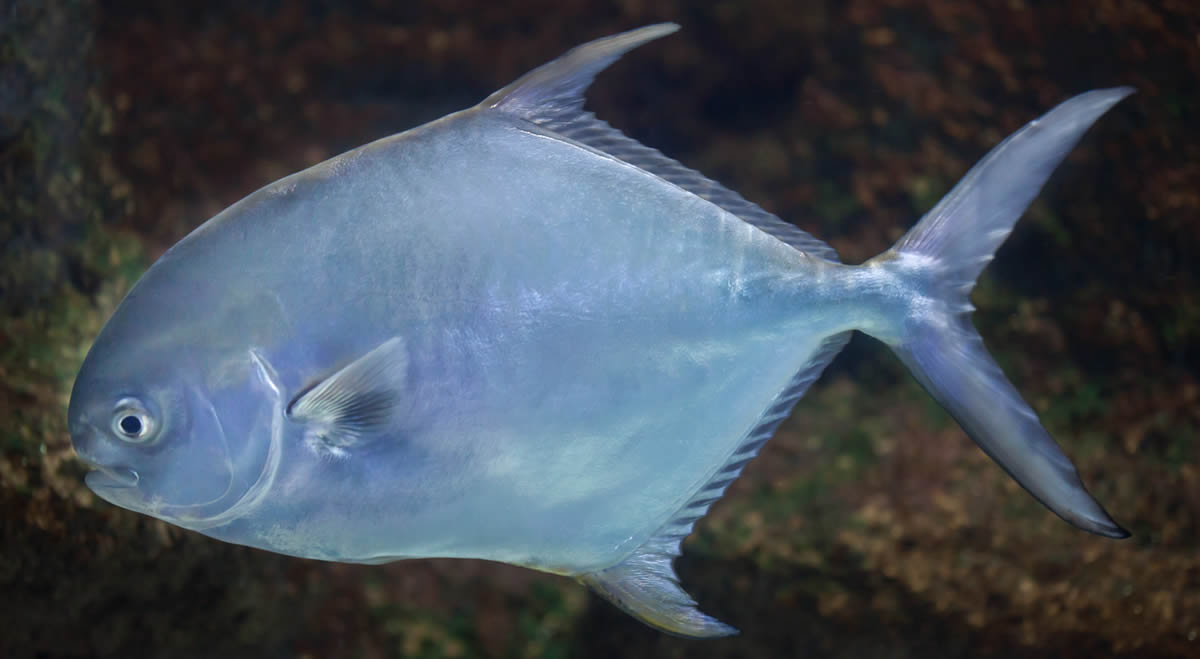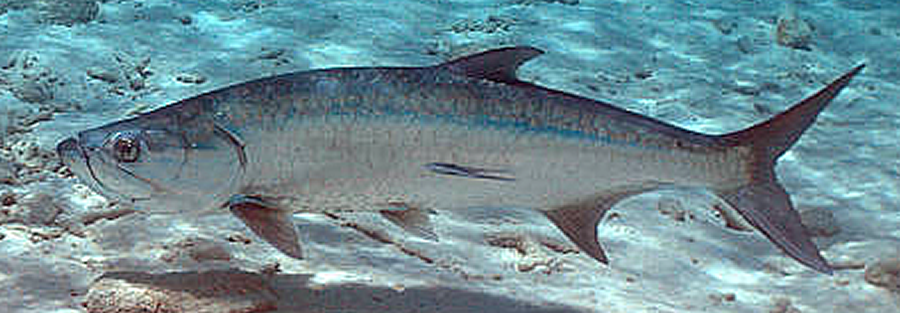Fishing
Ascension Bay is in a massive protected wilderness area, the Sian Ka’an Biosphere Reserve, home to large populations of permit, bonefish, tarpon, snook and many other flats species that can all be caught on the fly.

Our expert guide teams lead anglers into these diverse waters each day in search of the fish of a lifetime. Each team is composed of a senior and junior guide who work together throughout the day managing the boat and assisting anglers in spotting and landing fish.
Typically, the senior guide oversees maneuvering the boat and spotting fish from the polling platform in back, while the junior stands with the angler up front and assists with line management and spotting the fish. All the guides can communicate in English and are ready to share some good jokes.
Our Boats
Our guides run 23-foot panga boats with either 50- or 60-horsepower outboard motors that handle the Ascension Bay conditions with ease. The boats are equipped with a back poling platform, a front casting deck with back brace, and cushioned seats in the center. All boats carry a marine radio, PFDs, first aid kit and two full 30-liter tanks of gasoline.
Your Time on the Water
The typical fishing day begins at 8am, though that can change due to weather, tides, or fish activity. Each morning the guides will meet anglers at the lodge and assist them to their boats at the beach a few steps away.
Before fishing, you will discuss the fishing options with the guides. While most anglers come to Ascension Bay to chase permit, there are many other species and habitats in the bay to explore, so it’s important that guides and anglers are on the same page about what the expectations are for the day.
Once on the water, the guides and anglers will make the run into the bay. Ascension Bay is enormous and the initial run from the lodge can take anywhere between 15 minutes to 1 hour depending on what species you’re after and where your guide decides to start the day. The guides will frequently move to several different spots throughout the day while searching for fish.
Around midday, the guide will find a shady spot nearby to park the boat to enjoy lunch. The afternoon is spent chasing fish, then anglers and guides will return to the lodge between 4pm and 5pm.
Preparing for Success on the Flats
Flats fishing is both one of the most challenging and most rewarding type of fly fishing adventure. The preparations that you make leading up to your trip can make a big difference in your success and overall enjoyment out on the flats. Review our recommendations in the following sections . . .
Practice Your Casting
Casting ability is a big factor in your success on the flats. Our guides will help you spot the fish and get you into position, but in the end, it’s all on you to deliver the fly to where it needs to be. We highly recommend that you take the time to get out and practice in the weeks before coming down here.
Below are a few tips of what and how to practice:
The Double Haul
Being able to double haul is critical to casting in the windy conditions that are a staple of the flats. There are many online videos that explain this cast, and the pros at your local fly shop are a great resource in learning this skill.
Minimize False Casts
Flats fish are typically in motion, so you may only have seconds to deliver the fly before your opportunity is gone. The ability to quickly load the rod and shoot line without making unnecessary false casts is key to maximizing your chances of catching fish.
Practice Situational Casting
Fish on the flats are not always encountered at 10 o’clock with the wind at your back. Although your guides will try their best to put you in a favorable position, you often have to make casts quickly and in difficult situations. Practice casting with different wind angles, and work on your back-cast, too.
Physical Fitness
Fishing the flats is a physically demanding activity. It is often necessary to wade long distances through muddy-bottomed flats in waist-deep water to get a shot at a fish. Just standing up on the bow of the boat requires good balance and utilizing muscles that are rarely used in other circumstances. Exercising and preparing your physical stamina will make a big difference in your ability to fish and finishing your trip as strong as you started it.
Fishing Tackle Recommendations
Ascension Bay Lodge has a pro shop with a selection of flies, leaders, and tippet for sale. We have free loaner rods available for our guests, but it is still highly recommended that you bring your own gear. We never know when one of our loaner rods might break or when we’ll run out of that certain hot fly, so we can’t guarantee availability.
The Go-To Setup
Ascension Bay is an incredibly diverse fishery, and it is not uncommon to encounter multiple fish species in the same area, so it is best to have a rod for each species available on the boat rigged up and ready to go. This includes a 7-8 weight rod for bonefish, a 9-10 weight rod for permit, and a 9-10 weight rod for tarpon and snook. Having a selection of rods will save you from wasting critical time re-rigging rods when you encounter other species. Below is a list of the recommended gear by species:
Bonefish (Macabí)
- 7wt or 8wt fly rod with matching weight-forward floating saltwater line
- 10ft, 10-12lb monofilament leaders
- 10-12lb fluorocarbon tippet
Flies: Gotcha, Mantis Shrimp, Squimp, Christmas Island Special, Crazy Charlies, and other similar bonefish patterns all in size 4-6. Colors in order of importance are tan, crystal, white, pink, orange, and chartreuse. You want differing weights for different water depths. (Bonefish flies can get chewed up quickly, so you can count on going through at least 5 flies per day.)

- 9wt or 10wt fly rod with matching weight-forward
floating saltwater line - 10-16ft, 16lb or 20lb monofilament leaders
- 16-20lb fluorocarbon tippet
Flies: Casa Blanca Raghead Crab, Original Raghead Crab, Kung Fu Crab, Avalon Fly, EP Spawning Shrimp Patterns, Squimps and other similar crab and shrimp patterns in sizes 2 and 4. Typically, light tan or white are the most successful colors, but it’s good to have a few darker colored flies in the box, too. You want a large selection of Permit fly patterns and weights to choose from, but you’ll only need a few of each type.

- 9wt or 10wt fly rod with matching weight-forward floating or intermediate sinktip saltwater line
- 9ft leader with 50-60lb shock tippet (You can buy premade shock leaders or just bring the materials and we can build them for you. Straight 50-60lb leaders also work just fine.)
Flies: Tarpon Toad, Black Death, EP Baitfish Patterns, Gummy Minnows, Tarpon Bunny, Gurglers and other Baitfish and Tarpon Crab patterns. Chartreuse, red, purple, black, white, olive and tan are great colors for tarpon and snook. All flies should be in sizes 1-2/0. Tarpon flies tend to be durable, so you’ll only need a few of each pattern.
Migratory Tarpon (spring and summer months)
- 11wt or 12wt fly rod with matching intermediate sinktip flyline
- 80-100lb shock tippet leader
Flies: Black Death, EP Baitfish Patterns, Tarpon Bunny, and other Baitfish patterns. Flies should be on at least a 3/0 heavy gauge hook. Weighted flies work very well.
Spinning Gear
- A 6ft-8ft medium or heavy-action spinning or casting rod with 20-30lb braided line is sufficient for most of what we encounter on the flats in Ascension Bay
- Bonefish/Permit: 12-20lb monofilament leader with 1/8oz-1/4oz jig heads with bucktail or smaller soft plastic jigs.
- Tarpon/Snook: 30-60lb fluorocarbon leader with 2/0-5/0 swimbait or rapalas with heavy duty hooks
- Barracuda: 30lb monofilament leader with 30lb wire tip. Green ‘cuda tube lures and poppers


